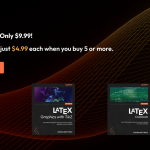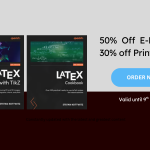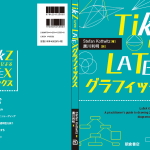The TUG 2015 started. In my previous post I wrote, what happens, and some details about my arrival yesterday, and the first evening gathering.
About 9 am, the current president of TUG, Steve Peter, opened the conference with some introduction words.
The topics of today were:
- PDF: enriching it and making it accessible
- Unicode: getting it into
- Past, present and future of TeX, LaTeX and fonts
- News and announcements
Let’s take a look at the presentations.
Ross Moore held the first talk. He spoke about semantical enrichment of mathematics. At first, he demonstrated the already available possibilities to add PDF tooltips to text and to math. Tooltips mean text boxes popping up, when you move over it with the mouse or cursor. While they won’t be printed, they add value to electronic documents. The reader is able to access further information, which is otherwise hidden to keep focused. Constructing math expressions with embedded semantics requires a difficult syntax though.
Ross Moore introduced a new package called mathsem. It offers a way to provide the semantic meaning separate from a math formula. Here’s an example:
\( %$semantics % x $ variable % f $ variable % f $ function % \Re $ real part of %$endsemantics y = f(x) \)
Now, the characters in the formula got their own tooltip. As you see, you can define semantics for macros. This is actally recommendable: define a macro with a name explaining the meaning, rather than how it’s typeset, and add semantic information to the macro.
The syntax is
% token $ semantics line end
It’s implemented by hacking cat codes of the commen symbol % and end-of lines, and then hooking in. This way has the benefit, that even without the package, everything just works, since the additions are hidden in comments and are actually looking just like code annotations, so still useful for themselves.
To ease work, mathsem provides a command \DeclareMathSemantics for repeated use, which is setting up default tooltips for symbols and macros. The tooltips can be also be used for screen reader, that means, for vocalization by assistive tools. Ross Moore showed several examples, and discussed the application to have spoken words for math, in the context of PDF/UA documents.
Following this, Olaf Drümmer explained, what PDF/UA means, in the following talk. UA stands for universal accessibility, which basically means that a document provides reasonable access to the PDF content. So, a visually impaired person could use a screen reader to get vocal information. It requires that all content is available as text, which means also images. Other demands are reliable, defined order, embedded semantics, a logical structure, metadata, and not using encryption.
Olaf Drümmer demonstrated screen reader software, a PDF/UA checker, and a visualizer tool.
PDF/UA is related to tagged PDF: a well tagged PDF can conform to PDF/UA.
Another talk by Ross Moore together with Peter Selinger gave us an update to new developments of the pdfx package, which helps producing documents conforming to PDF/A standards. Actually, there are various PDF/A-x standards. Now, the new version of pdfx supports most of them. Furthermore, the new version adds support for LuaTeX.
Now we got a coffee break. Just some minutes to fetch a coffee and to drink it, talking a bit, I wish it would be longer as I value such conversations during conferences. Herbert Voss and Martin Sievers found me and asked me, if I would write a conference report for the next DANTE member journal. Of course I’ll gladly do this. So, as I make notes anyway, I also talk what happened at the meeting, written here on LaTeX-Community.org.
Joseph Wright made the first talk after the break. While the first session was about PDF, we now come to the Unicode topic. He spoke about getting Unicode input into TeX, and about challenges dealing with it. For example, he explained the difficulties in uppercasing, lowercasing, titlecasing and casefolding. Details can make a developer get headaches, I feel. There are a lot of differences to consider in various languages.
Then Will Robertson came. At the stage, he changed roles. He grabbed his camera and said: “Everybody wave!” and took a picture of the audience. Then, he started with a retrospective about his development of the unicode-math package.
unicode-math allows us switching math font as easy as switching text fonts. There are thousands of math glyphs in various fonts, each one got a LaTeX name, but you can simply use it as input symbol. This can be done by code-auto-completion of the LaTeX-command to that symbol. May increase readability, but not in all cases, such as when we got too similar glyphs.
unicode-math gives direct access to a huge amount of symbols. A font with proper Unicode support is required, of course. Luckily, there are some.
LaTeX authors commonly use fonts to transport a meaning. In Unicode mathematics, you keep the same font but choose a symbol with the desired meaning. There are a lot of spacing challenges because it is done differently in math compared to text.
Subsequently, The GUST team discussed how characters for math fonts are chosen. That lead into a talk, if we really need new fonts, or if there’s not enough demand.
We heard about TeX Gyre math fonts, they were described with their underlying scheme, and with categorizing in bold, italic, sans-serif, double-stroke and more. Requirements were discussed such as scaling factors for subscripts and superscripts, math kerning, glyph links, growing glyph chains. We got 4200 glyphs in DejaVu Math alone, by the way.
But few companies produce OpenType math fonts. So, perhaps there’s no commercial pressure for math fonts, or not enough demand. So, a future task is possibly not making just another font, but font variants, such as sans-serif variants for presentations, or bold/heavy variants for headings.
Frank Mittelbach then talked about history and current development of LaTeX2e. Now, it’s 21 years old. The policy of compatibility will now change to a policy of roll back – roll forward. Fixes and enhancements will be applied directly to the kernel. You can call the latexrelease package with a date as option, then it would change to be compatible to the version of that date. Also packages can adjust their code to releases via an \IncludeInRelease macro. There will be also patch releases which will not be roll-back points, in contrast to major releases.
All fixes of fixltx2e are now in the kernel. e-TeX now included out-of-the-box, fundamental support for XeTeX and LuaTeX, a regression suite for testing with all formats. e-TeX and XeTeX passed the tests, still there are many failures in running against LuaTeX, to be determined.
Some Improvements:
\emphcan now produce small caps or others\textsubscriptis defined\DeclareMathSizesonly takes points- fewer fragile commands
The final speaker for the third session was Hans Hagen. His talk “What if” was more reflective. He looked at Unicode, which is nice to get rid of input encodings and font encodings, with easy transition thanks to existing UTF-8 support. And there sophisticated casing, categories, and spacing. What, if we had got it earlier? A lot of time was “wasted” struggling with encodings. However, Unicode may introduce challenges due to possibilities, cultural issues of symbols, and persistent compatibility errors. And, there will exceptions due to user demands.
He reflected on TeX’s design, which is nice but may be boring sometimes. The look and feel may not fit some purpose such as schoolbooks. Generally, nice fonts help reading. Still, there are different opinions on design.
Hans Hagen explained that we still have insufficient but persisting standards. The market demands XML, in and out, and support of tagged PDF and EPUB. Then, he took a look at the development of speed and memory and how we can benefit today, such as saving time struggling with hardware constraints. What, if we had this 20 years ago? What would be our position today? We compete with WYSIWYG and real-time rendering, so we should explorer today’s hardware benefits with more effort. Though, constraints can lead to better solutions.
He finished with a look at perspectives. Will TeX become niche or mainstream? Will it be a backend? Or just used by individuals?
Requirement for quality doesn’t grow; other apps can do well too. Can we focus on control, and on cultural aspects? The future is not clear.
A short break came right in time, so we could have some ice cream in the hotel café. Joseph Wright then gave an update on the status of the UK TeX FAQ. The Cambridge server is not available any more. So, the FAQ moved to another server, maintained by me. The original and established domain name has been preserved. Now, while I like to help in continuing, improving accessibility and web design, the UK TUG team will continue maintaining it. Joseph Wright asked for people helping to improve the FAQ content. This work load can be shared, so anybody could focus on a specific part. The FAQ sources are on github for further development.
Joachim Schrod informed us about the services provided by CTAN. An essential part of it is providing LaTeX packages to chosen servers, which in turn sync them to about 200 mirror servers. That’s for us TeX distribution users, who use this to update our packages. And this is really a main task of all the CTAN related servers, noticeable on the lots of Terabytes moving. Other services, such as manually browsing package directories, are less used, as this is done probably by developers but not end users.
The whole archiving and mirroring involves challenges such as observing mirror server status and checking their up to dateness. The heart of CTAN is the TeX catalogue. Maintainance of packages and their meta data is a laborious and important fundament of the archive. Besides incoming mirroring, there are services such as web server, wikis, and mailing lists, such as for upload management and for the operation of dante.de. With a look at the load on the CTAN servers for users, Joachim Schrod confirmed Hans Hagen’s words, that TeX may be a niche, but said it’s a large one.
Finally, Barbara Beeton and Volker RW Schaa gave words in memoriam of Pierre MacKay, Richard Southall and Hermann Zapf, who passed away.


